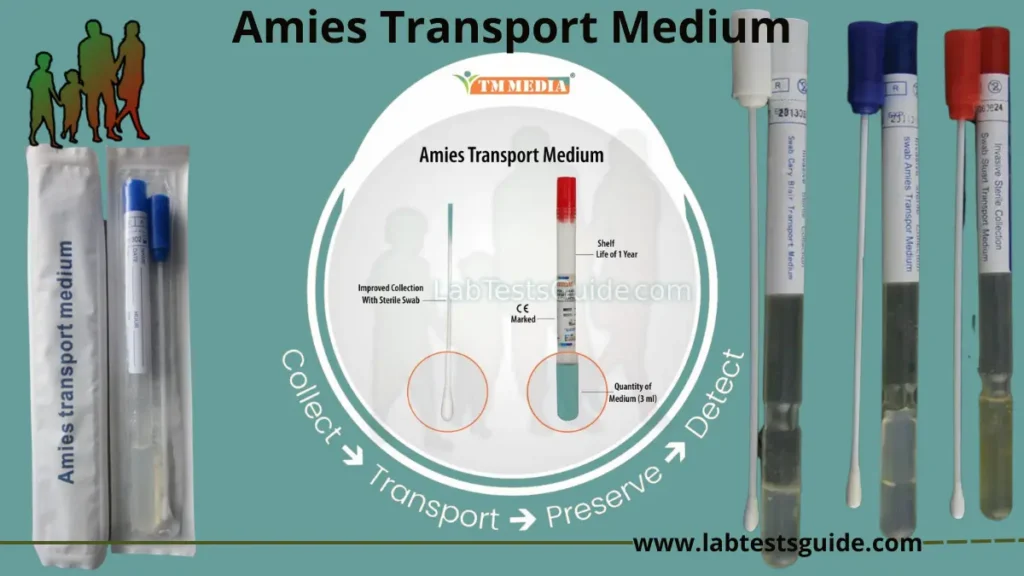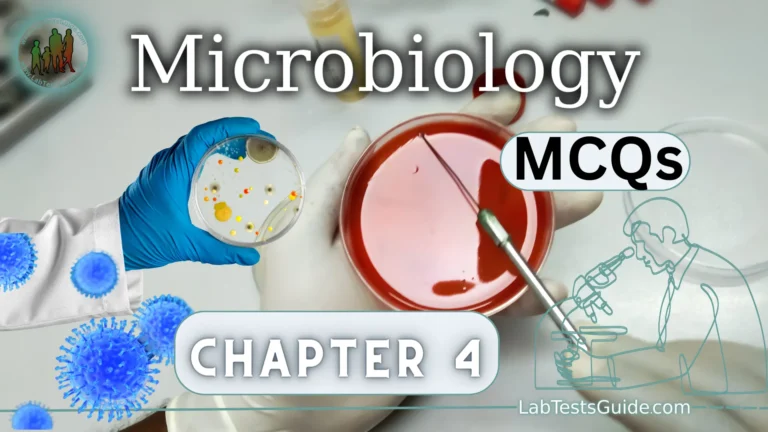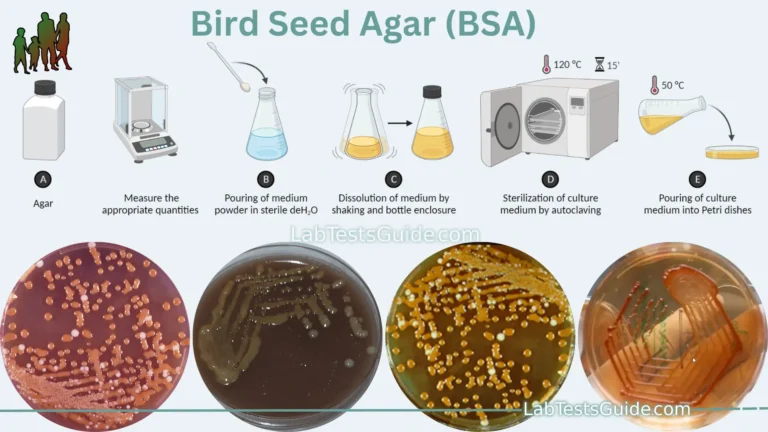Amies Transport Medium is a type of bacterial culture medium used to preserve and transport specimens of clinically significant bacteria to a laboratory for further analysis. It is made up of a liquid medium that contains nutrients and a solidifying agent, typically agar. The medium is designed to keep the bacteria in a viable state during transport, allowing for accurate identification and susceptibility testing. It is commonly used to transport specimens of respiratory, urinary, and wound infections.

What is Amies Transport Medium ?
Amies transport medium is a type of culture medium used to maintain the viability of microorganisms during transport from one place to another. It was first described by Amies in 1967 and is commonly used in clinical microbiology for transporting clinical specimens to the laboratory for culture and sensitivity testing.
The Amies transport medium contains a nutrient broth that supports the growth of bacteria, along with a buffering system to maintain the pH of the medium. The medium also contains a reducing agent to prevent oxidation of the sample and antibiotics to inhibit the growth of unwanted organisms.
The transport medium is available in both liquid and gel forms, with the gel form being more commonly used as it reduces the risk of spills and contamination during transport. The gel also acts as a semi-solid matrix, providing support for fragile organisms during transport.
Overall, the Amies transport medium provides a convenient and effective means of preserving the viability of microorganisms during transport, which is critical for accurate and timely diagnosis of infections.
Purpose of Amies Transport Medium:
Overall, the purpose of Amies transport medium is to ensure the survival and integrity of microorganisms during transport, which is critical for accurate diagnosis and appropriate treatment of infectious diseases.
Uses of Amies Transport Medium:
Amies transport medium is primarily used for the transportation of clinical specimens that contain microorganisms, including:
- Swabs from wound sites, abscesses, or other infected areas for bacterial culture and identification.
- Stool samples for the detection and identification of enteric pathogens, such as Salmonella, Shigella, and Campylobacter.
- Respiratory specimens, such as sputum or bronchoalveolar lavage fluid, for the detection and identification of bacterial, fungal, or viral pathogens.
- Genital specimens, such as vaginal or cervical swabs, for the detection and identification of sexually transmitted infections, such as chlamydia and gonorrhea.
- Ocular specimens, such as conjunctival swabs or corneal scrapings, for the detection and identification of ocular infections.
- Other clinical specimens that may contain microorganisms, such as blood, cerebrospinal fluid, and urine.
In addition to transportation, Amies transport medium may also be used for the short-term storage of clinical specimens prior to microbiological analysis in the laboratory. The medium can help to maintain the viability of microorganisms during this time, which can improve the accuracy and sensitivity of microbiological analysis.
Principle of Amies Transport Medium:
The principle of Amies transport medium is to provide a suitable environment for the survival and maintenance of microorganisms during transportation from the collection site to the laboratory. The medium contains a nutrient broth that supports the growth of bacteria, along with a buffering system to maintain the pH of the medium.
The medium also contains a reducing agent, such as charcoal, to prevent the oxidation of the sample, which can damage or kill microorganisms. Additionally, antibiotics may be added to the medium to inhibit the growth of unwanted organisms that may contaminate the sample during transport.
The Amies transport medium may be in liquid or semi-solid (gel) form. The gel form provides additional support and protection for fragile microorganisms during transport, reducing the risk of damage or death.
The principle of Amies transport medium is based on the fact that microorganisms require specific environmental conditions to survive and grow, including nutrients, pH, and protection from oxidative stress. By providing these conditions, the Amies transport medium ensures the viability and integrity of microorganisms during transport, which is essential for accurate and timely diagnosis of infectious diseases.
Composition of Amies Transport Medium:
The composition of Amies transport medium may vary depending on the manufacturer, but typically contains the following components:
- Potassium chloride: ( 0.2 Grams/Liter)
to improve the osmotic balance and growth of certain microorganisms. - Sodium chloride: (3.0 Grams/Liter)
to maintain osmotic balance and prevent cell lysis. - Calcium chloride: (0.1 Grams/Liter)
to stabilize bacterial cell walls and promote cell survival. - Magnesium chloride: (0.1 Grams/Liter)
Some time can be used to supplement the medium and improve the recovery of certain types of bacteria. - Charcoal: (10.0 Grams/Liter)
a reducing agent that absorbs toxic substances and prevents oxidation of the sample. - Agar: (4.0 Grams/Liter)
used in the gel form to provide a semi-solid matrix for support of fragile organisms during transport. - Monopotassium phosphate: (0.2 Grams/Liter)
to provide additional nutrients that can support the viability of bacteria during transportation. - Disodium phosphate: (1.150 Grams/Liter)
helping to maintain the pH of the medium - Sodium thioglycollate: (1.0 Grams/Liter)
for the cultivation and maintenance of anaerobic bacteria. - Antibiotics: may be added to the medium to inhibit the growth of unwanted organisms that may contaminate the sample during transport.
Overall, the composition of Amies transport medium is designed to provide a nutrient-rich and protective environment that maintains the viability and integrity of microorganisms during transportation from the collection site to the laboratory for culture and sensitivity testing.
Preparation of Amies Transport Medium
The following is a general protocol for the preparation of Amies transport medium:
- Dissolve 20 g of all above Items in 1 liter of distilled water.
- Mix well to ensure that all components are dissolved.
- Heat the mixture to boiling while stirring constantly to dissolve the agar.
- Sterilize the medium by autoclaving at 121°C for 15 minutes.
- If using a pH indicator, add it to the medium after autoclaving and mix well.
- If using antibiotics, aseptically add them to the cooled medium after autoclaving and mix well.
- Dispense the medium into sterile screw-cap tubes or vials in appropriate volumes (usually 1-3 mL per tube or vial).
- Allow the medium to solidify by cooling and store the tubes or vials in a cool, dark place until ready for use.
- Use sterile, cotton-tipped swabs on wooden sticks to collect the specimen.
- Push the swab down one-third of the medium depth and cut the stick so that when the cap is screwed down, the swab is forced to the bottom of the medium.
- Make sure the cap is screwed firmly on the bottle and keep cool during the transport period.
It is important to follow manufacturer’s instructions or established laboratory protocols for the preparation of Amies transport medium to ensure its quality, sterility, and suitability for the intended application.
Result Interpretation on Amies Transport Medium:
Amies transport medium is not typically used for direct interpretation of results, as its primary purpose is to maintain the viability of microorganisms during transport from the collection site to the laboratory for further analysis. Once the sample has been transported to the laboratory, it may be inoculated onto appropriate culture media for isolation and identification of microorganisms.
The results of culture-based analysis of clinical specimens depend on a variety of factors, including the type of specimen, the site of infection, the microbial population present, and the sensitivity and specificity of the culture media and identification methods used. Interpretation of these results requires knowledge and expertise in microbiology and clinical medicine.
In general, the presence or absence of microbial growth on culture media can provide information about the type and quantity of microorganisms present in a clinical specimen. Additional tests, such as biochemical assays or molecular methods, may be used to identify the microorganisms and determine their antibiotic susceptibility, virulence factors, and other characteristics.
It is important to follow established laboratory protocols and quality control measures to ensure accurate and reliable interpretation of microbiological results.
| Organisms | Growth |
|---|---|
| Escherichia coli | Good recovery on subculture |
| Klebsiella pneumoniae | Good recovery on subculture |
| Neisseria meningitidis | Good recovery on subculture |
| Pseudomonas aeruginosa | Good recovery on subculture |
| Salmonella Typhi | Good recovery on subculture |
| Shigella flexneri | Good recovery on subculture |
| Staphylococcus aureus subsp. aureus | Good recovery on subculture |
| Vibrio cholerae | Good recovery on subculture |
| Bacteroides fragilis | Good recovery on subculture |
| Haemophilus influenzae | Good recovery on subculture |
| Neisseria gonorrhoeae | Good recovery on subculture |
| Streptococcus pyogenes | Good recovery on subculture |
Limitations of Amies Transport Medium
Although Amies transport medium is a commonly used medium for the transport of clinical specimens for microbiological analysis, it has several limitations that should be taken into consideration:
- Selectivity: Amies transport medium may not be selective enough for certain types of microorganisms, which can affect the accuracy and sensitivity of microbiological analysis.
- Viability: The medium may not maintain the viability of all microorganisms equally well, particularly fastidious or delicate organisms, which can lead to false negative results.
- Contamination: The presence of other microorganisms or contaminants in the clinical specimen may interfere with the viability and growth of the microorganisms of interest during transport and storage.
- Storage: The quality of the medium and the viability of microorganisms may be affected by inappropriate storage conditions, such as exposure to light, high temperatures, or humidity.
- Transport time: The longer the transport time, the greater the risk of loss of viability or overgrowth of contaminants, which can affect the accuracy and sensitivity of microbiological analysis.
- Volume limitations: The amount of clinical specimen that can be transported in Amies transport medium is limited, which can be a constraint in certain types of clinical specimens or analyses.
It is important to be aware of these limitations and to use appropriate controls and quality assurance measures to ensure accurate and reliable results when using Amies transport medium for the transport of clinical specimens.
Advantages and Disadvantages:
Amies transport medium has several advantages and disadvantages that should be considered when selecting a transport medium for clinical specimens.
Advantages:
- Maintains viability of microorganisms: Amies transport medium helps to maintain the viability of microorganisms during transport, ensuring that they remain intact and suitable for analysis in the laboratory.
- Improved accuracy and sensitivity: By maintaining the viability of microorganisms, Amies transport medium can help to improve the accuracy and sensitivity of microbiological analysis.
- Reduced risk of contamination: Amies transport medium is designed to minimize the risk of contamination during transport, which can help to ensure the integrity of the specimen.
- Ease of use: Amies transport medium is easy to use and can be prepared and dispensed quickly and easily in the laboratory.
- Cost-effective: Amies transport medium is relatively inexpensive compared to other transport media, making it a cost-effective option for clinical laboratories.
Disadvantages:
- Limited storage time: Amies transport medium has a limited storage time, typically up to 48 hours, after which the viability of microorganisms may be compromised.
- Selectivity limitations: Amies transport medium may not be selective enough for certain microorganisms, which may require specialized transport media.
- Volume limitations: Amies transport medium may have volume limitations, making it unsuitable for large or bulky specimens.
- Viability limitations: Amies transport medium may not maintain the viability of all microorganisms equally, which may result in reduced sensitivity or accuracy of analysis for certain microorganisms.
- Contamination risk: Although designed to minimize contamination, there is still a risk of contamination during transport and storage, which may compromise the integrity of the specimen and the accuracy of analysis.
In summary, Amies transport medium has several advantages and disadvantages that should be considered when selecting a transport medium for clinical specimens. Its ability to maintain the viability of microorganisms during transport makes it a valuable tool in microbiological analysis, but its limitations should be taken into account when selecting a transport medium.
FAQs (frequently asked questions):
What is Amies transport medium used for?
Amies transport medium is primarily used for the transport of clinical specimens that contain microorganisms.
What is the composition of Amies transport medium?
The composition of Amies transport medium typically includes charcoal, agar, sodium chloride, calcium chloride, potassium chloride, magnesium chloride, monopotassium phosphate, disodium phosphate, and sodium thioglycollate.
How is Amies transport medium prepared?
Amies transport medium can be prepared by dissolving the components in distilled water, sterilizing the mixture, and dispensing it into sterile tubes.
What are the limitations of Amies transport medium?
Some of the limitations of Amies transport medium include selectivity, viability, contamination, storage, transport time, and volume limitations.
How long can specimens be stored in Amies transport medium?
Specimens can be stored in Amies transport medium for a limited period of time, typically up to 48 hours, depending on the type of microorganisms and the storage conditions.
How does Amies transport medium compare to other transport media?
Amies transport medium is one of several transport media that are used for the transport of clinical specimens. The choice of transport medium depends on the type of specimen, the microorganisms of interest, and the laboratory protocols.
What are the advantages of using Amies transport medium?
The advantages of using Amies transport medium include maintaining the viability of microorganisms during transport, improving the accuracy and sensitivity of microbiological analysis, and reducing the risk of contamination.
What are the disadvantages of using Amies transport medium?
The disadvantages of using Amies transport medium include limitations in selectivity, viability, and storage time, as well as the need for appropriate quality control measures.
Can Amies transport medium be used for viral transport?
Amies transport medium is not typically used for the transport of viruses, as viruses require specialized transport media to maintain their viability.
Can Amies transport medium be used for anaerobic transport?
Amies transport medium is not typically used for the transport of anaerobic microorganisms, as it contains sodium thioglycollate, which promotes aerobic growth.
Conclusion:
In conclusion, Amies transport medium is a commonly used transport medium for the transportation of clinical specimens containing microorganisms. Its composition, which includes charcoal, agar, various salts and thioglycollate, helps to maintain the viability of microorganisms during transport and storage. However, there are limitations to its use, such as selectivity, viability, and storage time, which should be considered when selecting a transport medium. Despite these limitations, Amies transport medium remains a valuable tool in microbiological analysis and can help to improve the accuracy and sensitivity of microbiological testing.
References:
- “Amies transport medium.” Thermo Fisher Scientific. Accessed March 30, 2023. https://www.thermofisher.com/order/catalog/product/R0185C.
- “Amies transport medium.” Medical Microbiology. Accessed March 30, 2023. http://www.antimicrobe.org/b76.asp.
- “Amies transport medium.” Microbe Notes. Accessed March 30, 2023. https://microbenotes.com/amies-transport-medium/.
- “Amies transport medium.” BD. Accessed March 30, 2023. https://www.bd.com/en-us/offerings/capabilities/microbiology-solutions/specimen-collection/amies-transport-medium.
- “Amies transport medium.” VWR International. Accessed March 30, 2023. https://us.vwr.com/store/search?label=Amies+transport+medium&x=0&y=0.
Possible References Used





